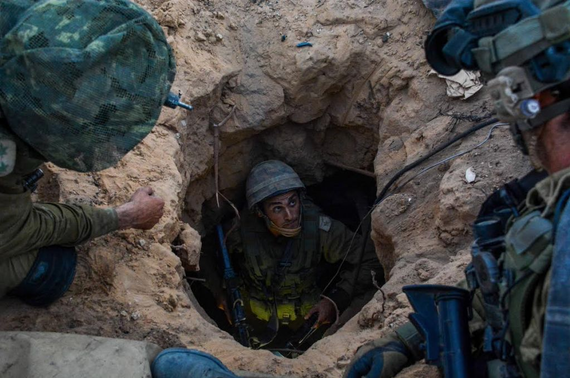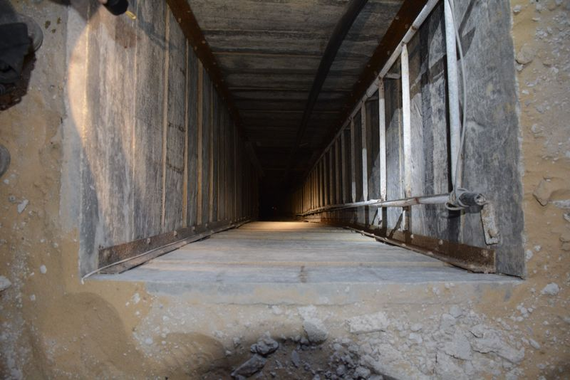Amid a shaky and uncertain ceasefire with Hamas, Israelis did not celebrate in the streets as Hamas and the people in the Gaza Strip did with fireworks and rifles shot in the air. As long as the force behind the rocket fire and a massive underground tunnel terror network remains in power and is backed by Qatari funds, Israelis remain wary.
An article published in the Institute for Palestine Studies two years ago by the Economist reporter, Nicolas Pelham, thoroughly examines the development of Gaza’s tunnel phenomenon over the past 10 years — a network described as “an underground city,” according to an Israeli military spokesman, Capt. Eytan Buchman in July.
“Much to the misfortune of the people of Gaza, Hamas has invested far more resources in “underground Gaza” than in “upper Gaza” wrote Shlomi Eldar for news source Al-Monitor. “The ‘change and reform’ that Hamas offered its voters was invested in its tunnels at the expense of the people of Gaza.”
While Hamas’s tunnel infrastructure was once utilized exclusively for smuggling weapons, funds, good and terrorists into the Gaza Strip, Operation Protective Edge revealed that Hamas has expanded its extensive tunnel network into Israel — to attack and kill IDF soldiers and Israeli civilians living in communities on the border.
The IDF estimates that today Hamas invests more than $1– $10 million into the excavation and maintenance of every tunnel, which equals 350 truckloads of building supplies. It goes without saying, that with those materials, Hamas could have invested into the welfare of its own people, using that money to build medical clinics, homes, mosques and schools. Instead, with Israel discovering and demolishing 36 tunnels during the war, Hamas wasted over $90 million with its underground terrorist infrastructure.

IDF soldiers from the Givati Brigade seen at the entrance to a Hamas ‘attack tunnel’ on Wednesday, July 23, 2014. (Photo Credit: IDF Spokesperson’s Unit/Flash90)
Indeed, Hamas has been engaged in the tunnel industry for the past 14 years since its rise to power in 2007. Prior to Operation Cast Lead, the Islamist movement of Hamas oversaw a sophisticated and complex underground tunnel program, utilizing Google Earth to map routes and to stay on course. Each tunnel dug cost anywhere from $80,000 to $200,000 to build. According to Pelham’s published report in 2012, mosque preachers praised the commercial tunnel ventures as “resistance” activity and hailed workers killed on the job as “martyrs.”
“Private investors, including Hamas members who raised capital through their mosque networks, partnered with families straddling the border. Lawyers drafted contracts for cooperatives to build and operate commercial tunnels, which detailed the number of partners, the value of respective shares and the way to distribute shareholder profits,” wrote Pelham.
These ‘partners’ comprised of all sectors of Palestinian society. Pelham cites Abu Ahmad, a taxi driver who invested $20,000 of his wife’s jewelry to partner with nine others in a tunnel ‘venture.’ Within a month, a trade tunnel under joint-partnership could generate revenue to cover its initial construction costs, with Gazan and Egyptian partners and owners splitting earnings equally.
From a few dozen factional tunnels in mid-2005, Hamas’s takeover of the Gaza Strip in 2007 ensured that by December of 2008 during Operation Cast Lead, the tunnels now numbered to at least 500. According to Penham’s article, the tunnel trade revenue in 2005 stood at an average of $30 million per year. But after Hamas entered the picture, the tunnel revenue increased to $36 million per month. Meanwhile, the Gaza Strip has remained in poverty with the per capita income in 2011 listed at $1,165.
The Hamas Interior Ministry even established the Tunnel Affairs Commission (TAC) in 2009 following Operation Cast Lead to oversee and regulate tunnel activities as well as ensuring safe working conditions, particularly when 160 children used by Hamas as child laborers, were killed digging underground tunnels.
Following Operation Cast Lead, donations for cement were needed to rebuild new and damaged buildings in Gaza. However a report by the Intelligence and Terrorism Information Center this August revealed that significant priority was given to rebuilding Hamas military infrastructure. A substantial amount of cement was allotted to building the extensive system of attack tunnels and smuggling tunnels under Gaza’s urban landscape. Hamas also utilized the cement to build most of its military infrastructure in densely-populated territory as part of its combat strategy.
Palestinian military sources told Al-Monitor that the tunnel discovered by Israel near Kibbutz Ein Hashlosha from Gaza in October 2013 cost an estimated $10 million and required 800 tons of concrete. Over 100 diggers worked on the tunnel for more than two years, equipping it with a communications network and electricity as well as stockpiles of cookies, yogurt and other foods that would last for several months. During the war itself, the IDF discovered within the terror tunnels, AK-47 assault rifles, rocket-propelled grenades, mortars and motorcycles.
Hamas recently indicated to international press that it would continue building up its underground network while restocking arsenal, rockets and other weaponry. As one Hamas fighter told a Reuters news reporter last week who visited an underground tunnel in Gaza, “In peace we make preparations, and in war we use what we have readied.”
Photo: Access point to a Hamas terror tunnel.
http://www.huffingtonpost.com/anav-silverman/another-hamas-ceasefire-c_b_5728406.html











